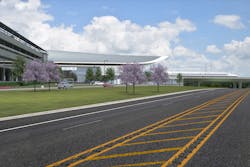Texas High-Speed Train Unveils Passenger Station in Brazos Valley
Developers of the Texas Bullet Train have unveiled new details on its passenger station in the Brazos Valley, giving riders quick and comfortable access for their travels instead of being stuck on traffic-clogged roads.
Texas Central said the terminal will be built on 60 acres in the Roans Prairie area of Grimes County, ideally located along Highway 30 and just west of Highway 90, about equidistant between College Station and Huntsville.
The station announcement comes a month after federal regulators overseeing the project said in an environment analysis that the Houston-to-North Texas train would “alleviate the strain” on the state’s existing infrastructure and “is needed to accommodate growing demand.”
The station — the only midway stop on the line — will have efficient roadway access and connection options for passengers coming to and from the facility. And it will be a catalyst for economic development, new jobs and additional tax revenue for local counties and communities, said Brady Redwine, a vice president of Texas Central.
“You’re going to see investment from the commercial community, businesses, universities and other institutions because of the station,” Redwine said. “This really creates a super community of employees and employers, headquarters and educational institutions in a way we have never seen before.”
“This will drive growth in Texas not only to the big cities but also to the areas around the station. It’s going to be very exciting,” Redwine said.
Included in the Federal Railroad Administration’s Draft Environmental Impact Survey (DEIS), Texas Central released simulated photos — the final designs are not complete — for the Brazos Valley station. Its structures, materials and finishes would be integrated into the environment as best as possible, the DEIS said.
The DEIS identified a preferred route for the bullet train, mostly following transmission lines in a utility corridor between North Texas and Houston. The report provides additional guidance as the project moves into its pre-construction phases, ensuring the safety and environmental wellbeing of counties and communities along the 240-mile route.
The terminal, being built on open land, is part of a $1 billion investment that Texas Central is making in Grimes County, including track construction and system and maintenance facilities. Texas Central, an investor-owned project, is not taking federal or state grants for construction or its operations. The company already has agreements with the current owner of the site.
Plans call for a shuttle service that will directly link the Texas A&M University campus to the station as well as other nearby connections. From there, it will be a roughly 50-minute train ride to Dallas or a 30-minute ride to Houston.
The train will create 10,000 jobs during each year of construction and about 1,000 full-time jobs when operations start, including 124 in Grimes County — equivalent to about 37 percent of the county’s unemployment base, the DEIS said.
Local companies also will benefit from construction work, such as building the system and maintenance facilities, supplying materials and providing long-term support for the new high-tech train industry.
“Fast, reliable and economically competitive transportation could increase the supply of skilled workers available, decrease the costs of work-related travel and improve supply chains for an overall positive impact,” the DEIS said.
The federal report said property values around the Brazos Valley station are expected to increase because of the new developments.
The project also will provide new tax revenue, paid by railroad company on its facilities, benefiting schools, libraries, parks, municipal utilities, hospitals, emergency services and other entities funded through property taxes.
All three stations, in Houston, Dallas and the Brazos Valley, would be environmentally friendly, minimizing energy and water usage and promote indoor air quality.
